Crinum: Care Guide for Flower
Crinum flowers are a show-stopping addition to any garden, known for their bold, lily-like blooms and sweet fragrance. These large perennials thrive in warm climates and are particularly suited for tropical and subtropical landscapes. With their tall stalks, strap-like leaves, and dramatic blossoms in shades of white, pink, or deep red, Crinum lilies make a powerful visual impact. Their flowers bloom in clusters, often with a delicate perfume that adds sensory appeal to outdoor spaces.
Crinums are also incredibly resilient, adapting well to various soil types and withstanding both drought and excessive moisture. While they prefer full sun, they can tolerate partial shade, making them versatile in different garden settings. Once established, Crinum bulbs are long-lasting and can flourish for decades with minimal maintenance. Their blend of beauty, durability, and fragrance makes Crinum an excellent choice for gardeners looking to add structure and elegance to their planting beds. Our gardening blog is a perfect place to find all the information you need!
Why Choose Crinum for Your Garden or Home?
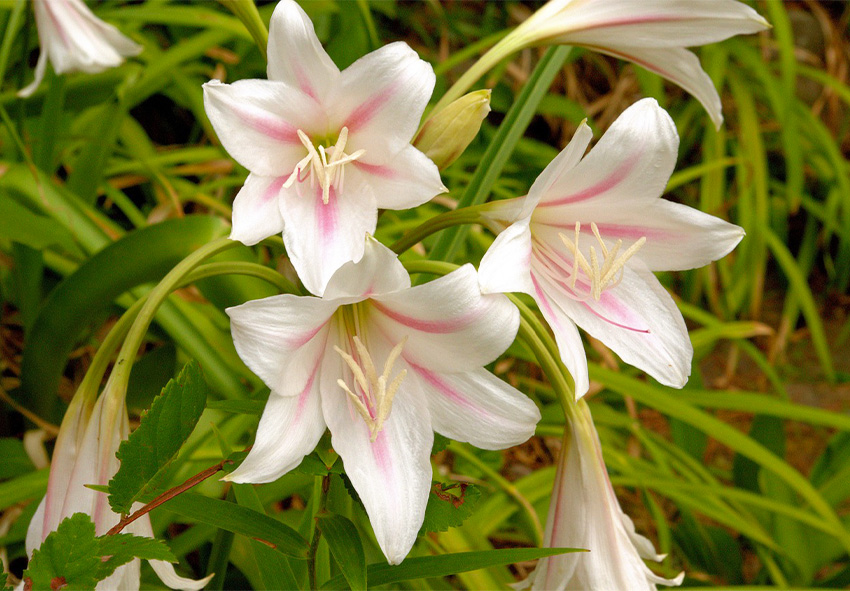
Crinum is an exceptional plant for gardeners who value both visual impact and ease of care. One of the biggest advantages of Crinum is its resilience. These hardy perennials can survive drought, flooding, and even poor soil, making them ideal for low-maintenance gardens. Once established, their bulbs can live and bloom for decades, providing long-term beauty without constant replanting. Crinum’s large, trumpet-shaped flowers come in a variety of shades—white, pink, rose, and deep red—making them adaptable to any color scheme in your garden. Their rich fragrance adds a luxurious sensory layer to your outdoor space, attracting pollinators like bees and butterflies.
Crinums also have strong architectural value thanks to their lush, strappy foliage and tall flower stalks. Whether planted in beds, borders, or near water features, they provide an elegant tropical touch. Additionally, they can be grown in containers in cooler climates and brought indoors during winter. Their low-maintenance nature, impressive longevity, and stunning appearance make Crinum a fantastic choice for gardeners seeking a bold and dependable bloom. With proper placement and crinum bulb care, these plants can become a striking focal point in your garden for years to come.
The Most Popular Crinum Varieties and Their Characteristics
Crinum offers a wide range of striking varieties, each with its own appeal in color, bloom shape, and size. One of the most iconic is Crinum asiaticum, known for its large white blooms and vigorous growth. This variety is excellent for coastal or tropical gardens due to its salt tolerance and bold presence. Crinum moorei is another standout, featuring soft pink blossoms with a delicate fragrance, often favored in subtropical landscapes. Crinum ‘Ellen Bosanquet’ boasts deep rose or wine-red flowers and is prized for its compact form and strong perfume, making it ideal for borders or containers. For gardeners looking for something unique, Crinum x powellii is a hybrid known for its profuse pink blooms and adaptability in both warm and temperate zones. Meanwhile, Crinum americanum, or swamp lily, thrives in wetter soils and features striking white star-shaped flowers. These varieties not only bring visual beauty but also contribute to garden structure with their tall stems and lush foliage. Whether you’re aiming for a tropical look or simply want long-lasting, dramatic blooms, Crinum varieties offer flexibility and performance. With so many cultivars to choose from, there’s a Crinum suited for nearly every climate, soil type, and garden style.
Classic White and Pink Crinum Varieties
Classic white and pink Crinum varieties bring timeless beauty and gentle elegance to garden spaces. These popular selections are known for their soft hues, lush foliage, and reliable blooming performance. Whether used in mass plantings, borders, or as striking specimen plants, these Crinums offer charm and visual appeal season after season.
- Crinum asiaticum: A tall, bold variety with striking white flowers and wide, glossy green leaves. It’s often found in tropical or coastal gardens and handles heat and salt well.
- Crinum powellii ‘Album’: This hybrid variety is prized for its large, trumpet-shaped white blooms and hardiness in a range of climates. It’s a strong grower and a favorite for mid-to-large garden beds.
- Crinum moorei : A pure white version of the beloved Crinum moorei, this variety adds grace and fragrance to shaded areas or bright garden borders.
- Crinum bulbispermum: With pale pink to rose blooms, this tough South African species tolerates both drought and flooding, making it very adaptable.
Fragrant and Exotic Crinum for Sensory Gardens
If you’re looking to create a garden that appeals to more than just the eyes, fragrant and exotic Crinum lilies are an outstanding choice. Their rich perfume and bold, tropical blooms create a sensory paradise that draws in visitors—both human and pollinator alike. These Crinum varieties are ideal for sensory gardens, near patios, or along walkways where their scent can be appreciated up close.
- Crinum powellii: Known for its elegant, bell-shaped pink flowers and heady fragrance, this Crinum thrives in warm, moist environments and partial shade.
- Crinum jagus: Native to West Africa, this white-flowered species is deeply fragrant and highly ornamental, making it a standout in tropical settings.
- Crinum x herbertii: A hybrid with a strong, sweet scent and soft pink blooms that emerge from bold green foliage, perfect for garden paths.
- Crinum zeylanicum: This exotic beauty boasts spiral-shaped white petals with red stripes and a spicy fragrance, adding flair and aroma to any tropical border.
Dwarf and Compact Crinum for Small Gardens
Not all Crinum lilies grow into large, towering plants—some are perfect for compact spaces or container gardening. These dwarf and small-statured varieties retain all the beauty and fragrance of their larger cousins but are more manageable in scale. They’re ideal for patios, balconies, or tight garden corners where space is limited.
- Crinum ‘Menehune’: This compact variety features striking burgundy leaves and pink flowers. It’s a favorite for containers or small garden beds and adds both color and texture.
- Crinum americanum: Also known as the swamp lily, this native variety has slender white flowers and does well in moist, shady areas. It stays relatively small and manageable in garden settings.
- Crinum ‘Stars and Stripes’: A compact hybrid with striped foliage and pale pink blooms, it’s perfect for pots or raised beds.
- Crinum oliganthum: This lesser-known species is smaller in stature and thrives in well-drained, sunny locations, making it a versatile pick for small landscapes.
Rare and Tropical Crinum Hybrids
Rare and tropical Crinum hybrids bring exotic beauty and botanical intrigue to gardens. These special selections often feature unique bloom shapes, unusual colors, or enhanced fragrances. Though harder to find, these varieties are well worth the search, especially for collectors or gardeners seeking standout plants that add a tropical flair.
- Crinum ‘Ellen Bosanquet’: This celebrated hybrid produces deep wine-red blooms with a rich fragrance and compact growth habit, making it a prized specimen in any garden.
- Crinum x digweedii: Known for its bright pink, spidery flowers, this hybrid blooms repeatedly through the warm months and adds drama to beds and borders.
- Crinum ‘Summer Nocturne’: A hybrid with darker foliage and star-shaped reddish blooms, it stands out in both tropical and formal garden designs.
- Crinum ‘Pink Flamingo’: Rare and eye-catching, this hybrid features soft pink blooms with flared petals and a strong perfume, perfect for garden focal points.
How to Plant and Grow Crinum Successfully
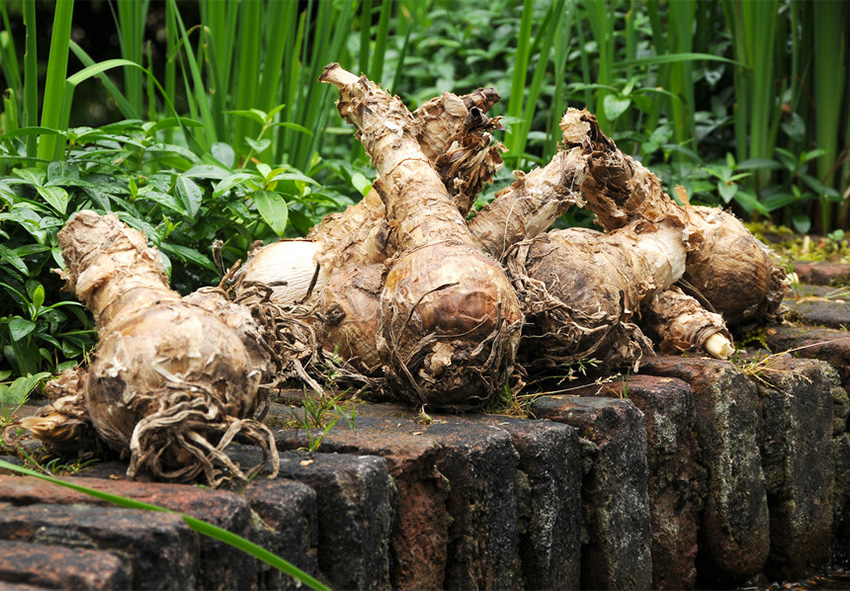
Crinum lilies are stunning tropical and subtropical perennials known for their dramatic, fragrant blooms and lush, strappy foliage. To ensure these plants thrive, it’s important to plant them correctly and provide proper care from the start. Crinums grow from large, fleshy bulbs that can live for decades, producing blooms year after year if planted in ideal conditions. Whether you’re adding them to a flower bed, border, or large container, following a few simple steps can help you establish healthy, long-lasting plants.
Start by choosing firm, healthy bulbs with no soft spots or mold. Select a sunny to partially shaded location with well-drained, fertile soil. When planting, place bulbs deep enough to keep them stable and spaced far enough apart to allow airflow. Water deeply after planting, then maintain consistent moisture without overwatering. Protect emerging shoots with mulch and shelter them from frost or harsh winds. With the right foundation, your Crinum lilies will reward you with spectacular blooms and vigorous growth season after season.
Step-by-Step Guide to Planting Crinum
Planting Crinum successfully starts with choosing high-quality bulbs and placing them in the right location. Proper depth, spacing, and watering are key to root establishment and future blooms. Protect young shoots and maintain good growing conditions to encourage long-term health. Follow the steps below to get your Crinum lilies off to a strong start.
Step 1: Choosing Healthy Crinum Bulbs
The success of your Crinum lilies starts with selecting the right bulbs. Look for large, plump, and firm bulbs, which indicate a healthy plant with a strong potential for growth. Each bulb should have a defined neck and, ideally, visible root stubs or signs of new growth. Avoid any bulbs that appear soft, shriveled, or have signs of rot, mold, or mildew—these are unlikely to establish well or may even infect nearby plants.
Healthy Crinum bulbs are often available from reputable nurseries or garden centers in spring or early fall. If ordering online, choose suppliers that specialize in tropical or bulbous plants to ensure freshness and proper handling. When receiving your bulbs, inspect them immediately and store in a cool, dry place until planting. A good-quality bulb is the foundation for strong root development and robust flowering in the seasons to come.
Step 2: Choosing the Right Soil and Location
Crinum lilies thrive in fertile, well-drained soil and warm, sunny locations. Select a planting site with a soil pH between 6.0 and 7.0—slightly acidic to neutral. While Crinum can tolerate partial shade, full sun exposure encourages better blooming and stronger foliage. Avoid areas prone to standing water or heavy clay soils, which can lead to bulb rot.
Before planting, enrich the soil with organic compost or aged manure to boost fertility and drainage. If needed, amend heavy soil with sand or perlite to improve structure. Raised beds or mounded garden spots work well in wetter regions. Crinum lilies can adapt to drought once established, but they prefer evenly moist soil in the growing season.
Choose a location sheltered from strong winds, especially for tall varieties. With the right soil and sun exposure, your Crinum will become a dramatic, fragrant focal point in the garden.
Step 3: Proper Planting Depth and Spacing
Planting Crinum bulbs at the correct depth and spacing is essential for their development. Dig a hole deep enough so that the bulb’s base sits 6–8 inches below the soil surface, with the neck of the bulb just peeking above the ground. This depth allows roots to establish firmly while keeping the growing point exposed to light and air.
Space each bulb about 18 to 24 inches apart to allow ample room for future growth. Crinum lilies are large plants that form substantial clumps over time. Crowded conditions can reduce airflow, increase disease risk, and limit blooming.
Once placed, fill the hole with soil, gently firming it around the bulb to eliminate air pockets. Water thoroughly after planting. Avoid pressing too hard, as bulbs can bruise. With proper depth and spacing, your Crinum lilies will develop strong roots, lush foliage, and abundant blooms in the growing season.
Step 4: Watering After Planting
Watering Crinum lilies correctly after planting ensures they establish a healthy root system. Once the bulbs are in the ground, water them deeply to help settle the soil and kick-start root development. Deep watering encourages the roots to grow downward rather than staying shallow, which improves drought tolerance later on.
Keep the soil consistently moist during the initial few weeks, but never waterlog it—soggy conditions can lead to rot, especially in cooler weather. As the plant grows, you can reduce frequency, allowing the top few inches of soil to dry slightly between waterings. In particularly dry or windy climates, monitor the soil more frequently.
Avoid overhead watering to prevent fungal diseases, particularly on young shoots. Instead, water at the base of the plant. Once Crinum lilies are fully established, they are fairly drought-tolerant but will bloom more consistently with regular moisture during the growing season.
Step 5: Providing the Right Growing Conditions
Creating the right environment after planting will help your Crinum lilies thrive year after year. These plants prefer warm, humid conditions but can tolerate light frost once mature. For newly planted bulbs, protect young shoots from strong winds and sudden temperature dips, especially in early spring or late fall. Using cloches, row covers, or even temporary windbreaks can shield vulnerable growth.
Apply a 2–3 inch layer of mulch around the base of the plant to help retain soil moisture, suppress weeds, and regulate temperature fluctuations. Organic mulches like bark chips or straw are ideal. Avoid piling mulch against the bulb neck, as this may cause rot.
Crinum lilies don’t require frequent feeding, but a slow-release balanced fertilizer in spring can support strong blooms. Monitor for pests like snails or aphids, and address issues early. With consistent care and favorable growing conditions, Crinums can live for decades and flower reliably every year.
Essential Crinum Care Tips for Healthy Growth
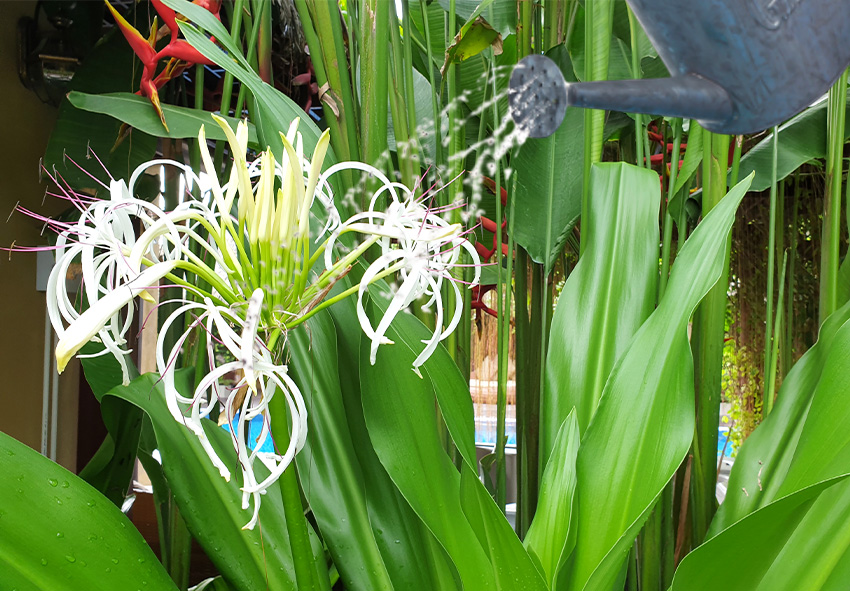
Crinum lilies are beloved for their bold, fragrant blooms and low-maintenance nature, but they still need the right conditions to flourish. After planting, consistent care ensures vigorous growth and repeat flowering year after year. These plants thrive best with adequate sunlight, occasional watering, and protection from extreme weather. Their resilience makes them ideal for both garden beds and large containers, but it’s still essential to follow basic care practices for optimal results.
Crinum prefers full sun but can tolerate partial shade, especially in hotter regions. Watering should be consistent but not excessive—overwatering can lead to root rot. Fertilizing during the active growing season supports strong stems and abundant flowers, but timing is key. Additionally, taller Crinum varieties benefit from support structures and deadheading to maintain their striking appearance.
Whether you grow them in a tropical landscape or temperate garden, following these care tips will help your Crinum plants thrive beautifully.
How to Care for Crinum After Planting
It’s important to know how to care for crinum indoors just as to learn how to care for crinum indoors. After planting Crinum bulbs, the right care routine is key to promoting healthy foliage and frequent blooms. Provide regular water, occasional feeding, full sun, and shelter from harsh conditions. With attention to these essential elements, Crinum will reward you with stunning, long-lasting flowers and lush greenery season after season.
Step 1: Watering Crinum the Right Way
Crinum lilies enjoy moist but well-drained soil. After planting, water deeply to establish strong roots, then continue watering once or twice a week depending on rainfall and temperature. In particularly hot or dry conditions, increase frequency, but always allow the topsoil to dry slightly between waterings to prevent soggy roots.
Avoid daily shallow watering, which promotes weak roots and increases the risk of fungal disease. Use a soaker hose or water at the base to keep foliage dry. During dormancy in colder months, reduce watering significantly.
Overwatering is one of the most common causes of poor growth or bulb rot in Crinum, especially in heavy soils. Ensure proper drainage and never let water pool around the base of the plant. A balanced watering schedule helps Crinum grow strong, with lush green leaves and healthy, fragrant blooms throughout the growing season.
Step 2: Fertilizing for Strong Growth
Crinum plants are relatively low-maintenance, but they benefit significantly from regular feeding during the active growing season. Begin fertilizing in early spring once new growth appears, using a balanced liquid fertilizer with a 10-10-10 NPK ratio. Apply every three to four weeks, ensuring you water the plant afterward to help nutrients absorb into the soil.
Avoid overfertilizing, especially with high-nitrogen products, as this may lead to lush foliage with fewer blooms. Once flower buds start forming, discontinue fertilization. This allows the plant to focus its energy on blooming rather than leaf production.
For garden-grown Crinum, a slow-release fertilizer can also be effective when applied in spring. In containers, feeding may need to be more frequent due to nutrient leaching from watering. Healthy fertilizing practices result in robust stems, vibrant leaves, and the stunning floral displays Crinum is known for.
Step 3: Providing Proper Light and Temperature
Crinum thrives in full sunlight, ideally receiving at least six to eight hours of direct light each day. Sunlight encourages healthy foliage growth and abundant blooms. While Crinum can tolerate partial shade, especially in hotter climates, too much shade can result in fewer or delayed flowers.
These plants enjoy warm conditions and are well-suited to tropical and subtropical climates. However, some varieties are frost-sensitive. In regions with cold winters, it’s essential to protect Crinum by mulching heavily or lifting and storing the bulbs indoors during dormancy.
Ensure good airflow around plants to prevent fungal issues, especially in humid environments. Crinum is quite resilient but can struggle in overly damp or cold, poorly ventilated areas. Providing the right balance of sun, warmth, and protection creates the ideal environment for Crinum to thrive and flower beautifully season after season.
Step 4: Supporting Tall Crinum Stems
Some Crinum varieties grow quite tall and produce heavy flower clusters, which can cause stems to droop or bend, especially during wind or rain. To prevent breakage and maintain an upright, elegant appearance, it’s helpful to provide support.
Install plant stakes or circular supports around young Crinum plants early in the season before they reach full height. As they grow, gently secure stems using soft garden ties or twine. This prevents damage and keeps the plant looking tidy and well-maintained.
Regular deadheading—removing faded flowers—can also help redirect energy toward new growth and reduce strain on the stems. To deadhead, cut back spent blooms just above the nearest set of leaves.
Supporting taller Crinum ensures the flowers remain visible and upright, making them a standout feature in any garden. Proper care combined with structural support leads to a healthier, longer-lasting bloom display throughout the season.
How to Encourage Your Crinum to Bloom Again
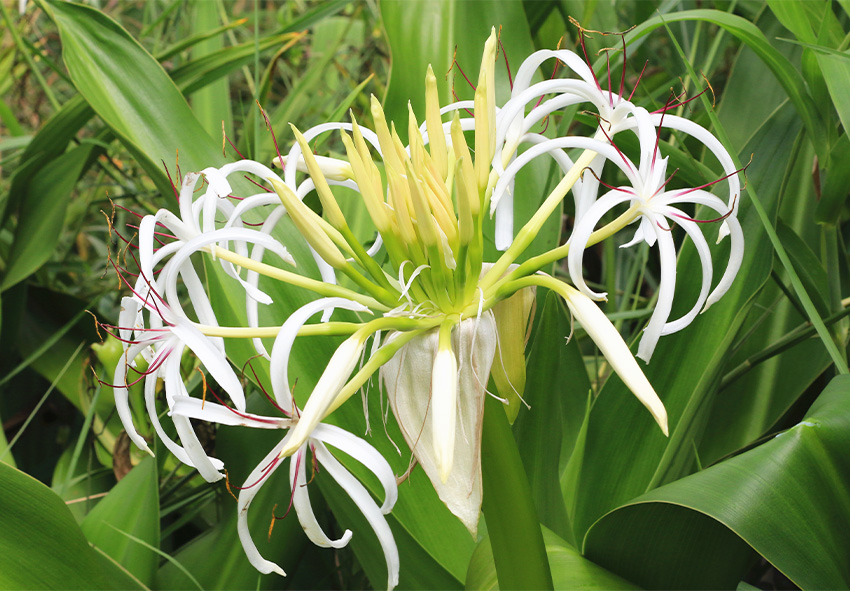
Crinum lilies are known for their large, fragrant blooms, but when they fail to flower year after year, it can be frustrating. Reblooming depends on several key factors, including proper care after flowering, seasonal rest, and the overall health of the bulb. Crinums are long-lived perennials that store energy in their bulbs, so managing their foliage, water needs, and spacing is essential to ensure abundant blooms in future seasons.
A common reason for lack of reblooming is inadequate post-bloom care—cutting foliage too early or failing to remove spent flowers. Overcrowding and nutrient-depleted soil can also slow blooming cycles. Encouraging Crinum lilies to flower again involves a gentle routine of deadheading, dormancy preparation, and periodic division to refresh and rejuvenate the plant. With a little attention and the right timing, Crinum will reward you with another round of breathtaking flowers.
Step-by-Step Guide to Ensuring Reblooming
To help your Crinum bloom again, follow these steps: deadhead old flowers promptly, allow the foliage to store energy after flowering, and reduce watering as dormancy approaches. Every few years, divide and replant bulbs in nutrient-rich soil. Consistent care and seasonal attention are key to successful reblooming.
Step 1: Deadheading and Post-Bloom Care
After your Crinum flowers have faded, it’s important to deadhead promptly to prevent the plant from directing energy into seed production. Use clean, sharp garden shears to remove spent flower stalks, cutting them back to just above the foliage. This redirection of energy helps strengthen the bulb for next season’s bloom.
However, never cut back the green leaves. The foliage plays a critical role in photosynthesis, storing nutrients in the bulb for future flowering. Let the leaves remain until they naturally yellow and die back. During this post-bloom period, continue regular watering and provide a balanced fertilizer if needed. Avoid high-nitrogen feeds, which can produce excessive leaf growth at the expense of flowers.
Proper post-bloom care helps ensure the bulb remains vigorous and ready for reblooming. By consistently deadheading and maintaining healthy foliage, you give your Crinum the best chance to produce a stunning display year after year.
Step 2: Preparing Crinum for Dormancy
Crinum lilies enter a period of dormancy, especially in cooler climates or after their bloom cycle ends. As fall approaches and the foliage begins to yellow, reduce watering gradually. This signals the plant to slow down and rest. Avoid cutting back healthy green leaves too early—let them die back naturally, as they continue to nourish the bulb until the plant is fully dormant.
In warm climates, Crinum may remain evergreen and only lightly rest. In colder zones, especially USDA Zones 7 and below, dig up bulbs after the first frost. Gently clean them, let them dry for a day or two, then store in a cool, dry, frost-free place over winter.
Proper dormancy care ensures Crinum bulbs aren’t stressed or rotting during the off-season. It also prepares them to emerge strong and bloom-ready in spring. Whether left in the ground or lifted for winter, rest is vital for consistent reblooming.
Step 3: Dividing and Transplanting Crinum
As Crinum bulbs mature, they multiply and form clusters. Over time, this overcrowding can reduce flowering, as the bulbs compete for nutrients, space, and light. Dividing Crinum bulbs every 3 to 4 years helps rejuvenate the plant and encourages stronger blooming.
The best time to divide is in early spring or late fall, depending on your climate. Carefully dig up the clump and separate the individual bulbs, ensuring each has roots and visible growth points. Discard any diseased or soft bulbs. Replant healthy ones in well-prepared, fertile soil with good drainage.
Give each bulb ample space—about 18 to 24 inches apart—so they can grow without competition. Water well after transplanting, and mulch to retain moisture. Dividing and replanting not only improves flowering but also allows you to expand your Crinum collection or share with others. A refreshed planting bed gives these majestic lilies the space and resources they need to thrive.
Common Problems with Crinum and How to Fix Them
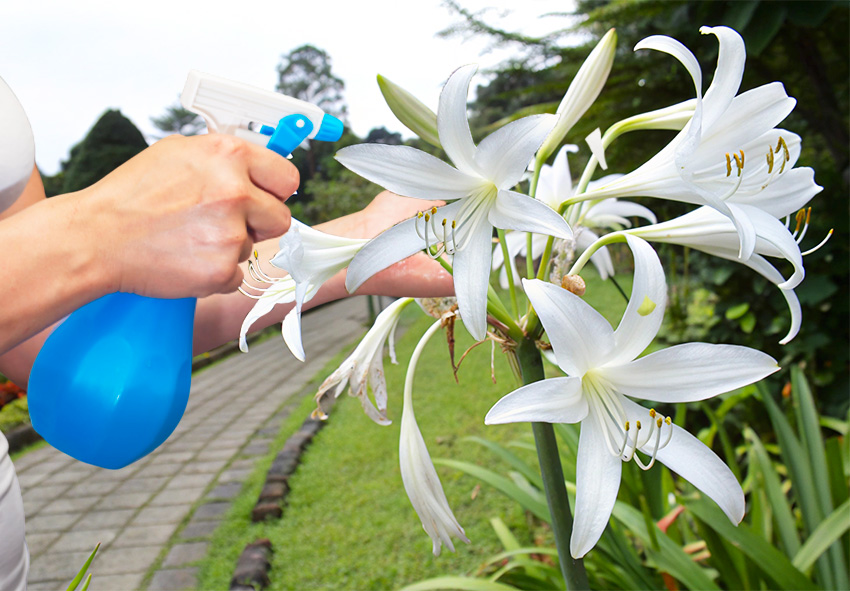
Crinum lilies are known for their resilience, but like all plants, they can occasionally run into trouble. Whether you’re dealing with poor blooms, drooping leaves, or bulb rot, understanding the cause and knowing how to respond can keep your Crinum healthy and thriving. Most common problems stem from environmental stress, improper care, or overcrowding. Fortunately, with a few adjustments in sunlight, watering, and spacing, you can restore your Crinum to its full glory.
Troubleshooting Guide
When Crinum shows signs of distress, pay close attention to light, soil conditions, and plant spacing. Addressing these areas early can prevent bigger issues later. From lack of blooms to yellowing leaves or bulb rot, proper diagnosis and quick action can ensure your Crinum remains vigorous, lush, and full of vibrant flowers.
Issue 1: Crinum Not Blooming
When your Crinum lily refuses to bloom, it can be frustrating. This issue is often due to environmental factors or overcrowding. Crinum lilies are sun-loving plants that require adequate light and space to produce their dramatic, trumpet-shaped flowers. If blooms are sparse or non-existent, it’s time to evaluate their surroundings and consider division. Here’s how to address the problem:
Common Causes:
- Not enough direct sunlight (less than 6 hours per day)
- Bulbs planted too deep or too close together
- Nutrient depletion due to overcrowding
Effective Solutions:
- Relocate plants to a spot with full sun exposure
- Dig up and divide bulbs every 3–4 years
- Replant bulbs 6–8 inches apart for better airflow and nutrient access
- Apply a phosphorus-rich fertilizer in early spring to promote flowering
Issue 2: Yellowing Leaves or Weak Growth
Yellowing leaves and limp stems are signs that your Crinum may be struggling with too much water or poor nutrition. These plants enjoy moist soil but not soggy conditions, and they need regular feeding to support their lush growth. If you’re noticing weak performance, here’s what to check:
Common Causes:
- Waterlogged or poorly draining soil
- Irregular watering or drought stress
- Lack of essential nutrients, particularly nitrogen and potassium
Effective Solutions:
- Amend soil with compost or sand to improve drainage
- Water only when the top inch of soil feels dry
- Use a balanced, slow-release fertilizer (10-10-10) every 4–6 weeks during the growing season
- Remove any dying foliage to prevent fungal infections
Issue 3: Crinum Bulbs Rotting
Bulb rot is one of the most serious problems that can affect Crinum. It usually occurs when bulbs sit in soggy soil for too long or are buried in an area with poor airflow. Once rot sets in, bulbs become soft, discolored, and may emit a foul odor. Prevention is key.
Common Causes:
- Heavy clay soil that holds too much moisture
- Planting bulbs too deep or too close together
- Lack of air movement in crowded beds
Effective Solutions:
- Improve soil by mixing in sand, perlite, or organic compost
- Space bulbs 18–24 inches apart for good ventilation
- Water deeply but infrequently, allowing soil to dry between waterings
- Mulch lightly to regulate moisture without trapping excess water
Propagating Crinum: Growing More Beautiful Blooms
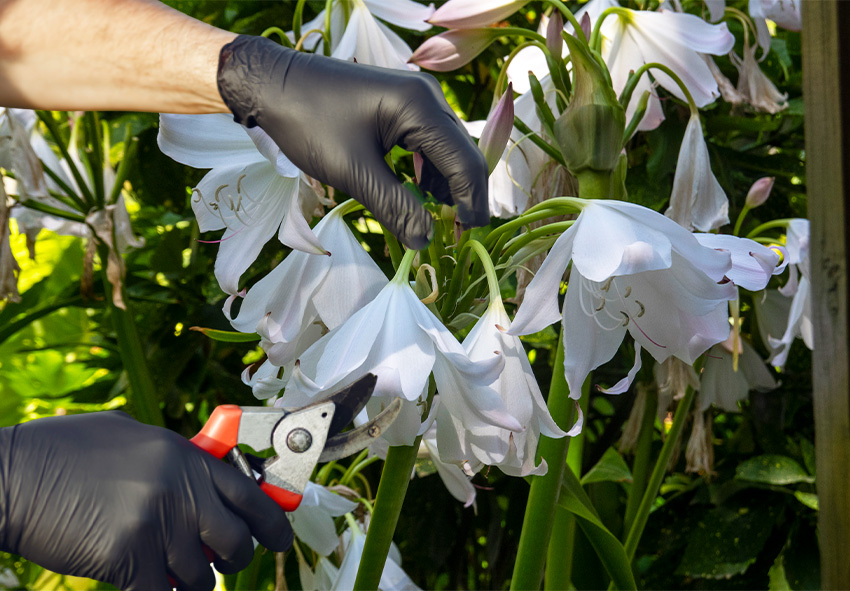
Crinum lilies are not only stunning in the garden but also quite easy to propagate, allowing you to multiply your collection or share their beauty with others. There are two main methods for propagating Crinum: dividing the bulbs and growing from seeds. Dividing Crinum bulbs is the quickest way to propagate them, as it produces mature plants more rapidly. When you divide bulbs, you separate the offsets (smaller bulbs that grow alongside the main bulb), each of which can be replanted and will grow into a new plant. This method typically results in blooms much faster than seed propagation.
On the other hand, growing Crinum from seed is a more time-consuming method, as it takes several years for the plants to flower. However, it’s an exciting and rewarding option for gardeners who are patient and want to introduce new genetic diversity into their garden. Although seed propagation can be slower, it offers the potential for unique flower colors and forms. Whether you choose to propagate Crinum by division or seeds, both methods offer a great way to expand your collection of these beautiful, fragrant flowers and continue to enjoy their spectacular blooms season after season.
How to Propagate Crinum Step-by-Step
To propagate Crinum successfully, you can either divide bulbs or grow them from seeds. Both methods allow you to enjoy more Crinum blooms in your garden, but they differ in time and effort. Dividing bulbs is quicker and provides new plants within a season, while seed propagation requires patience but offers the possibility of growing unique varieties.
Step 1: Dividing Crinum Bulbs (The Best Method)
Dividing Crinum bulbs is one of the most reliable methods for propagating these striking plants. Bulbs naturally produce offsets (smaller bulbs) around their base. These offsets can be separated and replanted to grow new Crinum plants. Follow these steps for a successful division:
- Timing: Dig up your Crinum bulbs in late summer after the foliage has begun to die back, signaling the start of dormancy.
- Separation: Gently pull apart the offsets from the main bulb. Each offset should have at least one healthy “eye” (growth point) for future sprouting.
- Replanting: Replant each offset in fresh, well-draining soil. Space them at least 18–24 inches apart to allow for optimal growth.
- Care: Water the new bulbs deeply after replanting, but avoid overwatering. Let them establish during the fall and winter months before seeing significant growth.
Step 2: Growing Crinum from Seeds
Growing Crinum from seeds is a slower but rewarding process. This method requires more patience, as Crinum lilies take several years to mature and flower. However, it’s an interesting way to explore new varieties or ensure the genetic diversity of your garden. Here’s how to grow Crinum from seeds:
- Harvesting Seeds: Crinum flowers produce large, showy seed pods that are usually ready for harvest once they turn brown and dry.
- Planting: Sow the seeds in a seed tray or small pots with a light, well-draining mix. Ensure the soil temperature stays warm (around 75°F or 24°C) to promote germination.
- Germination: Seeds may take 1–2 months to germinate, depending on temperature and humidity. Keep the soil moist but not soggy.
- Patience: Expect a long wait—Crinum lilies grown from seeds typically take 2–5 years to flower, but once they bloom, you’ll have a beautiful and unique plant in your garden.
By following these propagation techniques, you can enjoy even more Crinum lilies blooming in your garden, or give them as thoughtful gifts to others who appreciate these stunning flowers!
Frequently Asked Questions (FAQs) about Crinum
1. When is the best time to plant Crinum bulbs?
Crinum bulbs are best planted in the spring or early summer when the soil has warmed. These tropical bulbs need heat to grow well, so avoid planting in cold or overly wet conditions. Choose a sunny location with well-drained soil, and plant the bulb with the neck above ground. Since Crinum bulbs are large and long-lived, be sure to give them plenty of space to thrive.
2. How often should I water Crinum plants?
Crinum lilies prefer consistently moist soil, especially during the growing season. Water them regularly, but avoid soggy or waterlogged soil, as the bulbs can rot. Once established, Crinums are quite drought-tolerant and can handle short dry spells. In containers, check the soil more frequently, and reduce watering in the dormant season to allow the bulb to rest before the next growth cycle.
3. Can I grow Crinum lilies in pots indoors?
Yes, Crinum lilies can be grown in large containers indoors, but they need bright light and space. Choose a pot with excellent drainage and rich, loamy soil. Keep the bulb’s neck above the soil surface and place it near a sunny window. Water regularly but let the soil dry slightly between waterings. Crinums are slow-growing, so patience is key, but they reward with large, fragrant blooms.
4. Can I order Crinum bulbs from your online store?
Yes, you can! Our online store Dutch-bulbs.com offers a wide selection of crinum plants, including different varieties and colors. We take pride in providing top-quality plants that are carefully cultivated and shipped with care to ensure they reach you in perfect condition.
5. Are Crinum lilies hardy in cold climates?
Crinum lilies are not frost-tolerant and are best suited for USDA zones 8–11. In colder regions, they should be grown in pots and brought indoors before frost. If planted in the ground in mild climates, apply a thick mulch in winter to protect the bulb. Alternatively, you can dig up the bulb in fall, store it in a cool, dry place, and replant it the following spring.
Published: 15.04.2025
